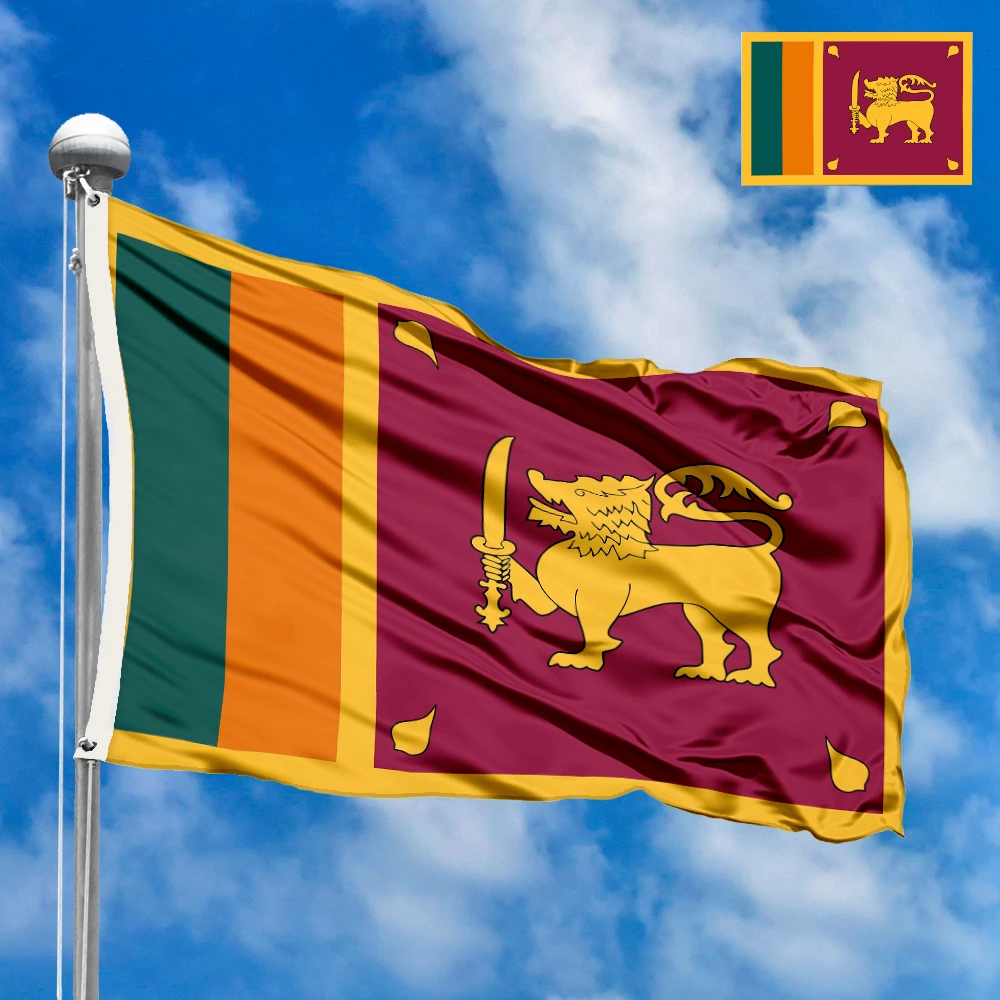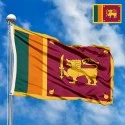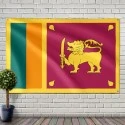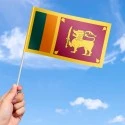The National Flag of Sri Lanka, affectionately known as the "Lion Flag" (Sinha Dhvaja), is a powerful and vibrant emblem that encapsulates the island nation's rich history, diverse heritage, and enduring aspirations. Adopted officially on February 4, 1948, the day Sri Lanka (then Ceylon) gained independence from British rule, and further refined in its current form in 1972, this flag is a visual narrative of the country's journey towards self-determination and unity. Its intricate design, replete with symbolism, tells a story of ancient kingdoms, religious harmony, and the resilience of its people.
A Visual Symphony: Description, Dimensions, and Element Arrangement
The Sri Lankan flag is a masterpiece of heraldic design, featuring a central golden lion passant (walking with the right paw raised) holding a kastane sword in its right forepaw. This lion, rendered in gold on a deep crimson (maroon) field, symbolizes the Sinhalese ethnicity, the island's majority population, and represents strength, courage, and nationhood. The sword signifies the nation's sovereignty and its fight for independence. In each of the four corners of the maroon field, there is a golden bo leaf. These four bo leaves symbolize the four concepts of Metta (loving-kindness), Karuna (compassion), Mudita (sympathetic joy), and Upekkha (equanimity), reflecting the profound influence of Buddhism, the predominant religion in Sri Lanka.
To the left of the maroon field, there are two vertical stripes: a saffron (orange) stripe and a green stripe. The saffron stripe represents the Tamil minority, while the green stripe symbolizes the Muslim minority. These two stripes collectively signify the peaceful coexistence and harmony among the various ethnic and religious communities within Sri Lanka. A golden border frames the entire flag, uniting all the elements and emphasizing the island's integrity and unity.
While specific official dimensions for website display can vary, the flag's overall ratio is typically 1:2 (height to length). The meticulous arrangement of the lion, sword, bo leaves, and the two vertical stripes within the golden border ensures visual balance and profound symbolic meaning. The colors are vibrant and distinct, chosen not just for aesthetic appeal but for their deep cultural and historical resonances. The crimson is rich and regal, the gold shines brightly, and the saffron and green offer a striking contrast that represents inclusivity.
Echoes of Time: The History of the Flag's Creation
The roots of the Lion Flag extend deep into Sri Lanka's ancient history, long before it became the national emblem. The golden lion holding a sword is an ancient symbol associated with Sinhala royalty and warrior traditions. Historical accounts suggest that a lion flag was used by King Dutugemunu in the 2nd century BCE, a revered figure who unified the island. This imagery continued through various Sinhalese kingdoms for centuries.
When Sri Lanka gained independence from British rule on February 4, 1948, a new national flag was needed to represent the newly sovereign nation. The traditional lion flag, which had been in use by the Kandyan kingdom until its fall in 1815, was brought back into prominence. However, to ensure inclusivity for the nation's diverse population, a committee was appointed in 1948 to propose modifications.
The design that emerged from this process, and which forms the basis of the current flag, was largely championed by A. E. Goonesinha, a prominent politician. The inclusion of the saffron (Tamil) and green (Muslim) stripes was a significant addition, aimed at representing the minority communities and fostering a sense of national unity. These stripes were added to the ancient lion flag, creating a modern symbol that acknowledged both historical heritage and contemporary diversity.
Further refinements were made in 1972 when Sri Lanka became a republic, dropping the "Ceylon" moniker. The most notable change was the replacement of the original four finials (spearheads) at the corners of the maroon field with the four golden bo leaves. This change explicitly emphasized the nation's commitment to Buddhist principles, further integrating spiritual values into the national emblem. The Act on National Flag of 1972 formally codified this refined design, solidifying its place as the enduring symbol of the Democratic Socialist Republic of Sri Lanka.
Sri Lanka's Identity Woven in Fabric: Significance for the Nation
The Lion Flag holds immense significance for Sri Lanka, serving as a powerful representation of its sovereignty, independence, and unique national identity. It visually encapsulates the nation's journey from colonial rule to a self-governing republic. The flag’s design subtly but effectively communicates the delicate balance between the majority Sinhalese culture and the significant minority communities, aiming to promote ethnic and religious harmony.
For the people of Sri Lanka, the flag embodies their resilience, cultural pride, and shared heritage. It tells a story of a vibrant nation with deep historical roots, a rich tapestry of traditions, and a profound spiritual foundation rooted in Buddhism. It is a symbol that unites its diverse population, reminding them of their collective strength and their aspiration for peace and prosperity. The flag is proudly displayed on government buildings, schools, and during national celebrations, fostering a strong sense of patriotism and national unity among all Sri Lankans, regardless of their background. It is a testament to the nation's ability to evolve while preserving its core identity.
Intriguing Facets: Interesting Facts about the Sri Lankan Flag
-
One of the Oldest Continuously Used Symbols: The lion with a sword motif is one of the oldest national symbols in the world, tracing its origins back over 2,500 years to the arrival of Prince Vijaya, the legendary ancestor of the Sinhalese.
-
The Bo Leaves and Buddhism: The four Bo leaves (from the sacred Bodhi tree under which the Buddha attained enlightenment) are a unique addition, directly reflecting the prominence of Buddhism in Sri Lankan culture and its guiding principles of compassion and equanimity.
-
Symbol of Inclusivity: The saffron and green stripes were specifically added to represent the Tamil and Muslim minority communities, making it one of the few national flags to explicitly incorporate symbols of its diverse ethnic groups.
-
Evolution of the Design: The flag has undergone several modifications over the centuries, with the most significant ones occurring at independence in 1948 and again when Sri Lanka became a republic in 1972, each change reflecting the evolving national identity.
-
Kastane Sword: The specific type of sword held by the lion is a "kastane," a traditional ceremonial sword native to Sri Lanka, further emphasizing the flag's unique local heritage.
-
Color Meanings: Beyond the main elements, the colors themselves hold significance: gold for prosperity, red/maroon for courage and resilience, saffron for Tamils, and green for Muslims.
-
Parliamentary Approval: The current design of the flag was meticulously debated and approved by the Sri Lankan Parliament, signifying a consensus on its symbolic representation of the nation.
The Moment of Transition: Adoption and Reception
The initial design of the modern Sri Lankan flag was officially adopted on February 4, 1948, coinciding with the momentous occasion of the country gaining independence from British colonial rule. This was a pivotal moment for the newly sovereign nation, as it marked its formal entry onto the world stage with its own distinct emblem. The design at this time included the lion and the two vertical stripes representing the minorities, but the corners featured traditional finials (spearheads) rather than the Bo leaves.
The flag was further refined and officially readopted in its current form on May 22, 1972, when Ceylon transitioned into the Democratic Socialist Republic of Sri Lanka. This update replaced the finials with the four golden Bo leaves, a deliberate choice to reinforce the nation's strong connection to Buddhist philosophy and its principles.
The reception of the flag throughout its history has been largely positive, especially among the Sinhalese majority who deeply identify with the ancient lion symbol. The inclusion of the saffron and green stripes in 1948 was a significant gesture of inclusivity and reconciliation towards the Tamil and Muslim minorities, though their acceptance has varied over time, particularly during periods of ethnic conflict. However, the flag today generally serves as a unifying symbol, proudly displayed by all communities as a representation of their shared homeland and national identity. Its adoption marked not just a political transition but a profound cultural and historical affirmation for the people of Sri Lanka.
A Beacon of Unity: Meaning for Residents
For the people of Sri Lanka, the Lion Flag is much more than a piece of cloth; it is a living testament to their history, their diversity, and their shared aspirations for a united future. It embodies the strength and courage represented by the majestic lion, reflecting the resilience of a nation that has endured centuries of challenges. The Bo leaves serve as a constant reminder of the profound Buddhist principles that guide much of the island's culture – a call for compassion, equanimity, and loving-kindness in their daily lives.
The saffron and green stripes are particularly poignant for residents, symbolizing the hope for lasting harmony between the various ethnic and religious groups that call Sri Lanka home. The golden border, enclosing all these elements, powerfully represents the unity and integrity of the island. When Sri Lankans see their flag, they are reminded of their rich heritage, their hard-won independence, and the ongoing journey towards a peaceful and prosperous nation where all communities can thrive together. It is a source of immense national pride, fostering a sense of collective identity and belonging across the island.
In the demonstration images, full-size flags are shown with proportions of 2:3, and hand-held flags with proportions of 1:2.






 Waving flag
Waving flag
 Sizes:
Sizes:
 Round flag
Round flag
 Sizes:
Sizes:
 Rectangular flag 2:3
Rectangular flag 2:3
 Sizes:
Sizes: